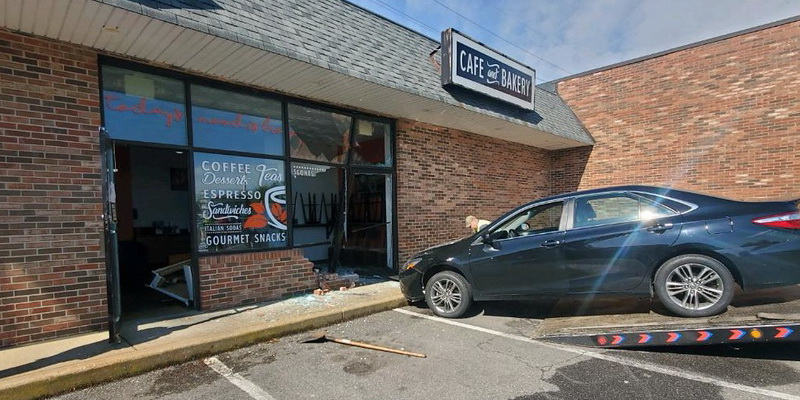You are using an out of date browser. It may not display this or other websites correctly.
You should upgrade or use an alternative browser.
You should upgrade or use an alternative browser.
The Beanery...
- Thread starter jazz lady
- Start date

Vehicle crashes into the Beanery Cafe in California - The BayNet
Vehicle crashes into the Beanery Cafe in California
 www.thebaynet.com
www.thebaynet.com
gemma_rae
Well-Known Member
Drive-In service. But Marvin Heemeyer could have made it thru!
MUST... HAVE... COFFEE!!!
itsbob
I bowl overhand
Coffee?? ohhhh, that would have been my second guess.MUST... HAVE... COFFEE!!!
PeoplesElbow
Well-Known Member
Damn its like old people driving through drugstores ( my 91 yo grandfather was one)
I know exactly how that person managed to do that because my mom did the same thing and smashed into a concrete wall.
Interesting that the car doesn't look that damaged yet it took out a block wall.
No, I don't understand how you can do that except just incompetence and in that case maybe it's time to turn in that license.
Gray hair was probably expecting special opening for them and was disappointed.
No, I don't understand how you can do that except just incompetence and in that case maybe it's time to turn in that license.
Gray hair was probably expecting special opening for them and was disappointed.
Interesting that the car doesn't look that damaged yet it took out a block wall.
No, I don't understand how you can do that except just incompetence and in that case maybe it's time to turn in that license.
Gray hair was probably expecting special opening for them and was disappointed.
From an article on SMNEWNET:
The occupant of the vehicle signed care refusal forms, and reported they confused the brake pedal, with the accelerator pedal
There is video at the link of the car being removed.

No Injuries Reported After Vehicle Strikes The Beanery Cafe in Hickory Hills Shopping Center in California
On Tuesday, April 21, 2020, at approximately 9:00 a.m., firefighters and police responded to the Hickory Hills Shopping Center in California, for the reported vehicle into a structure with no injuries.
Goldenhawk
Well-Known Member
I've seen a psychology analysis of this "confuse the pedals" problem. It really has nothing to do with not knowing which pedal is which. People aren't that dumb. Well, most people.
If you put your foot on the gas by mistake (some people don't have as good a sense of where their extremities are, or maybe they're just slightly rotated in the seat), and the car starts moving, you're quite convinced your foot is on the correct (brake) pedal, because it ALWAYS is in your experience. So you start pushing what MUST be the brake pedal HARDER trying to stop the car, because you've had decades of experience that teaches you to push to stop. Of course that makes it worse, and within just a fraction of a second it's too late because you've already moved quite a distance. It takes well longer than that for your reptile brain to give way to your rational brain and realize "Oh, my foot is in the wrong place."
So the only real mistake is the initial foot placement. Everything else is very simple and normal human psychology and muscle memory.
The real problem is a control system design that puts two nearly identical controls (that do opposite things) right next to each other - and with the potential for serious bad things that result from such a mistake. Anyone with aircraft control system design or test experience will instantly tell you that's a really, really bad idea.
But we consider it perfectly normal, don't we?
If you put your foot on the gas by mistake (some people don't have as good a sense of where their extremities are, or maybe they're just slightly rotated in the seat), and the car starts moving, you're quite convinced your foot is on the correct (brake) pedal, because it ALWAYS is in your experience. So you start pushing what MUST be the brake pedal HARDER trying to stop the car, because you've had decades of experience that teaches you to push to stop. Of course that makes it worse, and within just a fraction of a second it's too late because you've already moved quite a distance. It takes well longer than that for your reptile brain to give way to your rational brain and realize "Oh, my foot is in the wrong place."
So the only real mistake is the initial foot placement. Everything else is very simple and normal human psychology and muscle memory.
The real problem is a control system design that puts two nearly identical controls (that do opposite things) right next to each other - and with the potential for serious bad things that result from such a mistake. Anyone with aircraft control system design or test experience will instantly tell you that's a really, really bad idea.
But we consider it perfectly normal, don't we?
Were you born this stupid or did you evolve slowly ?I've seen a psychology analysis of this "confuse the pedals" problem. It really has nothing to do with not knowing which pedal is which. People aren't that dumb. Well, most people.
If you put your foot on the gas by mistake (some people don't have as good a sense of where their extremities are, or maybe they're just slightly rotated in the seat), and the car starts moving, you're quite convinced your foot is on the correct (brake) pedal, because it ALWAYS is in your experience. So you start pushing what MUST be the brake pedal HARDER trying to stop the car, because you've had decades of experience that teaches you to push to stop. Of course that makes it worse, and within just a fraction of a second it's too late because you've already moved quite a distance. It takes well longer than that for your reptile brain to give way to your rational brain and realize "Oh, my foot is in the wrong place."
So the only real mistake is the initial foot placement. Everything else is very simple and normal human psychology and muscle memory.
The real problem is a control system design that puts two nearly identical controls (that do opposite things) right next to each other - and with the potential for serious bad things that result from such a mistake. Anyone with aircraft control system design or test experience will instantly tell you that's a really, really bad idea.
But we consider it perfectly normal, don't we?
PeoplesElbow
Well-Known Member
I was going to say when I have my big steel toe boots on there isn't a lot of feeling in them and ive accidentally had the right side of the sole on the edge of the gas while my foot was on the brake. Generally I don't drive in these boots, but I have to wear them on the flight deck and I don't like packing another pair of shoes when I go aboard a carrier.
Not buying it. A lot of people wear heavy shoes for work and drive in foul weather
But I also am aware that some people drive with the right foot on the gas and the left on the brake.
First sign is they are accelerating with the brake lights on.
More likely they thought the car was in reverse and stomped the gas, only to realize that the car was in drive,
Fascinated by the damage to the building in relation to how bad the car looks.
But I also am aware that some people drive with the right foot on the gas and the left on the brake.
First sign is they are accelerating with the brake lights on.
More likely they thought the car was in reverse and stomped the gas, only to realize that the car was in drive,
Fascinated by the damage to the building in relation to how bad the car looks.


